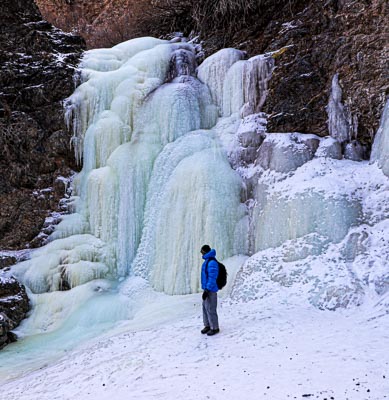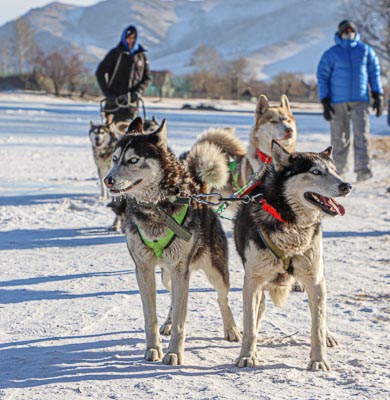There are only two million heads of Bactrian camels or two-humped camels in the world. The two-humped camels are native to Central Asian steppes. Among them, the camels in the Mongolian Gobi Desert are an inseparable part of the nomads' livelihood. Within the Camel Festival tour, you will travel into the depths of the Gobi Desert, and learn a lot about how the Gobi Desert nomads use camels for their daily life, the benefits of camel herding, and see how the two-humped camels used for fun and games. Moreover, the Gobi Desert camels are at their most majestic view in March. Therefore, you may have an eyeful picture of yourself on the back of this giant animal. Depending on your time and interest, we can combine the Mongolia Camel Festival Tour with the Winter Adventures of the Gobi Desert Tour.
Itinerary
February 1, Day 1: Drive to the Dalanzadgad
Meet with your guide and driver and start the adventure driving 580 km on paved roads of the vast open Gobi Desert steppes heading to Dalanzadgad town. Check-in at a hotel upon arrival in Dalanzadgad.
Accommodation: Local hotel
Meals: Lunch, Dinner

February 2, Day 2: Gurban Saikhan Mountain and the Camel Festival
After early breakfast, we will drive to Mukhar Shivert Valley in the Gobi Gurban Saikhan Mountain. After short trekking, see the frozen river looks like a frozen waterfall. It is a unique picture because the Gobi Desert is the coldest desert if we don’t consider polar deserts. The driving continues on the Gobi Desert steppes heading to the Camel Festival site near Bulgan town. The Camel Festival opening starts with a camel parade, which is a fascinating event as you will see hundreds of two-humped camels gathered at a place. Next, you will see a competition of the best traditionally dressed couple on gracefully looking camels, an ankle bone shooting competition, camel polo, camel products, and dairy products made from camel milk. Today’s event ends with a concert of school children of Bulgan town.
Accommodation: Local hotel
Meals: Breakfast, Lunch, Dinner

February 3, Day 3: The Camel Festival Continues
The second day of the festival starts with a camel race. There are two races; full-grown camels and two-year-old camels. You may bet on the two-year-old camel race to make your day more enjoyable. A demonstration of camel training, catching, and camel loading for nomadic migration are part of today's program. The festival ends when the winners of all competitions are prized.
Accommodation: Local hotel
Meals: Breakfast, Lunch, Dinner

February 4, Day 4: Return to Ulaanbaatar
We return to Ulaanbaatar and transfer to your accommodation. (580 km on paved roads, 100km on rough roads)
Meals: Breakfast, Lunch

Background
Is Mongolia Camel Festival Tour suitable for you?
The Bulgan town, where the Camel Festival takes place, is located 680 km distance from Ulaanbaatar. You will drive 580 km on paved roads to Dalanzadgad, a central city of Umnugobi province. The 580 km driving takes 8-9 hours. Stay at a hotel in Dalanzadgad and drive to Bulgan town the next day. The driving back to Ulaanbaatar will be longer as we drive from Bulgan town. The tour has not included any challenging activities, but staying in a fire heating gers/wood houses and having outdoor activities at -15°C to +12°C makes the tour moderate and experiential. Short camel riding with a support of a local camel herder is an experience.
When is the Mongolia Camel Festival Tour? Camel Festival Weather.
The Gobi Desert people celebrate the Camel Festival annually on the 6th and 7th of March. The beginning of March is spring, but the winter weather could continue until mid of March in some years. Snowfall and storms are common climatic conditions. Therefore, we suggest you bring warm clothes. As well as, please bring sunglasses and a scarf to protect you from dust. You should expect -10°C to +12°C daytime and +1°C to -15° at night. For your pre-departure preparation, please check the winter tour packing list
Accommodation
3 days local hotel stay included
Winter Tour Meals
All meals are authentic and native because you will eat in the local restaurants and food courts where the locals eat. The Bulgan town people will serve some traditional Mongolian meals and daily recipes. Eating course meals is not a Mongolian habit. Therefore, you will have one big meal at a time.
Mongolians consume a lot of meat, especially in winter, to gain enough protein to struggle against the cold temperature and high elevation. If high meat consumption is a problem, or if you have any dietary restrictions, please inform us in advance.
Guides
The majority of our company's guides are English speaking. We also have German, French, Spanish, Russian, and Japanese-speaking guides. They are all friendly and helpful. The majority of the guides were born and raised in the Mongolian countryside. Therefore, they have good knowledge about every aspect of Mongolia. Local guide will help you with the camel riding.
Tour drivers and transportation
Depending on the group size, Japanese/Korean vans or jeeps serve you. Our experienced drivers are friendly, flexible, and handy mechanics.
We can customize the itinerary with more Gobi Desert and Central Mongolia attractions if your wish.








